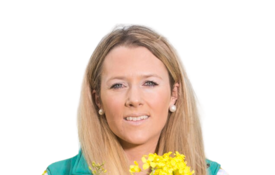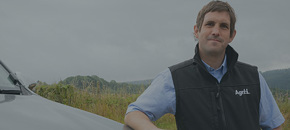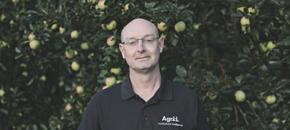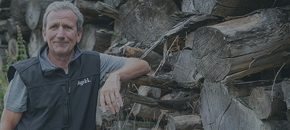Keep the Faith in OSR
Keep the Faith in OSR: Why Growers Should Reconsider Oilseed Rape
With UK oilseed rape (OSR) area down but 2024 crops looking promising, is it time to give OSR another go?
In this episode of Tramlines, host Tony Smith is joined by David Leaper, Seed Technical Specialist at Agrii, and Sarah Hawthorn, Head of Arable Products for DSV UK.
Together, they re-examine the value of OSR in the rotation, agronomic advances, pest pressures, and new breeding developments.
This Episode Features:

Tony Smith
Your Tramlines Host

David Leaper
Seed Technical Specialist

Sarah Hawthorne
Head of Arable Products - DSV
What’s the Current State of OSR in the UK?
David: Despite a tough spring, oilseed rape has coped well with dry conditions. Growers are optimistic, with many crops looking the best they have in years. The area has dropped significantly - down from 750,000 ha to around 220,000 ha - but what’s in the ground looks strong.
Sarah: Sunshine during flowering has supported good yield potential. OSR’s deep rooting helps it cope with drought, and rain on the forecast could create ideal harvest conditions. The decline in bees is concerning, but more OSR in rotations could support pollinator recovery.
Why Have Growers Stepped Away from OSR?
Sarah: OSR is a front-loaded crop with high upfront costs - expensive seed, herbicides, and fungicides. But breeding advancements and improved management mean risk can be reduced.
David: The main deterrents were blackgrass pressure in tight rotations and later, cabbage stem flea beetle (CSFB). These challenges caused a steady acreage decline, but better integrated pest management and wider rotations are helping.
What’s the Current Outlook on Cabbage Stem Flea Beetle?
Sarah: Wider rotations and harsh winters are helping reduce pest pressure. Many growers are also adopting companion cropping and other integrated practices.
David: While CSFB remains a threat, larval counts are lower. Strategic drilling and better agronomy are contributing to improved control. However, the pest remains widespread and persistent.
Why Is OSR Still Valuable in the Rotation?
David: OSR breaks cereal rotations, supports better weed management, and improves workload distribution. It’s drilled and harvested outside peak cereal timings, supports biodiversity, and remains one of the most profitable break crops.
Sarah: Growers like Tim Lamyman use OSR to boost following wheat yields. Its early harvest also creates more drilling windows. Combine that with strong market demand for vegetable oils, and OSR offers solid long-term value.
What Are the Latest Trends in OSR Breeding?
David: Breeding investment has dramatically improved OSR’s disease resistance, yield stability, and oil content. Traits like turnip yellows virus (TuYV) resistance, clubroot tolerance, and high vigour hybrids are now common.
Sarah: DSV now focuses 100% on hybrid OSR breeding for faster trait development. Hybrid vigour boosts drought tolerance and yield potential. We're also exploring new types of OSR with shorter growing seasons and earlier harvests to escape CSFB migration.
How Can Growers Manage CSFB More Effectively?
David: The “OSR Reboot” project brings together breeders, researchers, and agronomists to identify top strategies for CSFB control. Key findings show early drilling supports establishment but increases larvae. Later drilling avoids larvae but carries weather risks -especially in wetter regions.
Sarah: Trials with Phacelia and Berseem Clover companions show promising CSFB reduction. Early moisture-based drilling decisions are critical. DSV is also working on late-drilled hybrids that mature earlier to avoid peak pest pressure.
What Role Does Variety Selection Play in OSR Success?
David: Growers should prioritise:
- Autumn and spring vigour
- TuYV and clubroot resistance
- Resilience to light leaf spot and verticillium wilt
Sarah: Choose hybrids with compensation ability and earlier flowering to escape larvae. Talk to breeders and agronomists for the best-fit picks. Don’t be afraid to reintroduce OSR on a small, manageable scale.
How Are Seed Companies Helping to De-Risk OSR?
David: Around half the UK’s hybrid OSR seed is now backed by risk-share schemes, which refund seed costs if crops fail by October. Agrii also offers “reserve seed” - treated seed stored and ready for rapid replanting if needed.
Sarah: DSV supports growers with:
- Risk-share seed schemes
- Seed return options for dry conditions
- New late-drilled hybrids under development
What’s the Outlook for Autumn OSR Drilling?
Sarah: There's positive momentum. With current crops looking strong and prices holding, more growers will likely give OSR another chance. Targeting the right fields and using establishment schemes makes it a viable option again.
David: Follow best practice. Assess soil moisture, field suitability, and weather - not just the calendar. Pick proven, consistent varieties with rapid autumn growth and spring regrowth. Use guidance from the OSR Reboot framework to make informed decisions.
Want to Learn More?
Download your guide to the latest winter oilseed rape varieties and variety trials: Visit agrii.co.uk/your-crops/oilseed-rape
Related episodes
Gain with Grain: Sustainable Solutions from Agrii, Viterra & Whitworth
Episode 1Wheat That Works: Hexton and the Value of Variety Investment
Episode 5The Malting Barley Blueprint: Aligning Breeding, Farming and Market Needs
Episode 2Seed Success: Understanding Treatments, Science & Innovation
Episode 20Time to Start Carbon Auditing?
Episode 12Sowing the Seed
What's on your Variety Shopping List?
Raising the Bar on Variety Selection
The Importance of Analysing Soil and Plant Health
Never miss an episode of Tramlines








